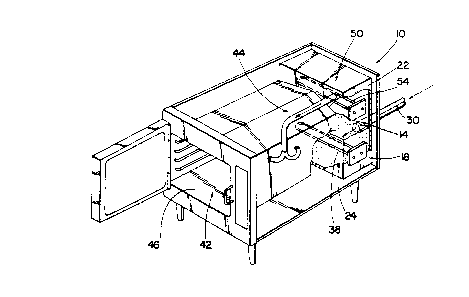Some of the information on this Web page has been provided by external sources. The Government of Canada is not responsible for the accuracy, reliability or currency of the information supplied by external sources. Users wishing to rely upon this information should consult directly with the source of the information. Content provided by external sources is not subject to official languages, privacy and accessibility requirements.
Any discrepancies in the text and image of the Claims and Abstract are due to differing posting times. Text of the Claims and Abstract are posted:
| (12) Patent: | (11) CA 2103031 |
|---|---|
| (54) English Title: | STEAM DRYING ELEMENT FOR STEAM COOKING DEVICE |
| (54) French Title: | ELEMENT DE SECHAGE DE LA VAPEUR POUR CUISEUR A VAPEUR |
| Status: | Term Expired - Post Grant Beyond Limit |
| (51) International Patent Classification (IPC): |
|
|---|---|
| (72) Inventors : |
|
| (73) Owners : |
|
| (71) Applicants : |
|
| (74) Agent: | SMART & BIGGAR LP |
| (74) Associate agent: | |
| (45) Issued: | 2000-11-28 |
| (86) PCT Filing Date: | 1992-05-12 |
| (87) Open to Public Inspection: | 1992-11-14 |
| Examination requested: | 1999-04-27 |
| Availability of licence: | N/A |
| Dedicated to the Public: | N/A |
| (25) Language of filing: | English |
| Patent Cooperation Treaty (PCT): | Yes |
|---|---|
| (86) PCT Filing Number: | PCT/US1992/003956 |
| (87) International Publication Number: | WO 1992020231 |
| (85) National Entry: | 1993-11-12 |
| (30) Application Priority Data: | ||||||
|---|---|---|---|---|---|---|
|
A steam cooking device (10) comprising a steam generating chamber (14) having
a steam generator (24), a cooking
chamber (42) adjacent to the steam generating chamber (14) For receiving steam
from the steam generator (24), a conduit (44) for
transporting the steam from the steam generating chamber (14) to the cooking
chamber (42) and a heating element (54) for heating the
steam to a superheated condition prior to the steam entering the cooking
chamber (42).
Un appareil de cuisson à la vapeur (10) comprend une chambre génératrice de vapeur (14) dotée d'un générateur de vapeur (24), une chambre de cuisson (42) adjacente à la chambre génératrice de vapeur (14) destinée à recevoir la vapeur provenant du générateur de vapeur (24), un conduit (44) destiné à transporter la vapeur depuis la chambre génératrice de vapeur (14) jusqu'à la chambre de cuisson (42), ainsi qu'un élément chauffant (54) destiné à chauffer la vapeur jusqu'à un état surchauffé avant qu'elle ne pénètre dans la chambre de cuisson (42).
Note: Claims are shown in the official language in which they were submitted.
Note: Descriptions are shown in the official language in which they were submitted.

2024-08-01:As part of the Next Generation Patents (NGP) transition, the Canadian Patents Database (CPD) now contains a more detailed Event History, which replicates the Event Log of our new back-office solution.
Please note that "Inactive:" events refers to events no longer in use in our new back-office solution.
For a clearer understanding of the status of the application/patent presented on this page, the site Disclaimer , as well as the definitions for Patent , Event History , Maintenance Fee and Payment History should be consulted.
| Description | Date |
|---|---|
| Inactive: Expired (new Act pat) | 2012-05-12 |
| Inactive: Late MF processed | 2011-05-17 |
| Letter Sent | 2011-05-12 |
| Inactive: IPC from MCD | 2006-03-11 |
| Letter Sent | 2003-05-28 |
| Grant by Issuance | 2000-11-28 |
| Inactive: Cover page published | 2000-11-27 |
| Pre-grant | 2000-08-23 |
| Inactive: Final fee received | 2000-08-23 |
| Notice of Allowance is Issued | 2000-02-23 |
| Notice of Allowance is Issued | 2000-02-23 |
| Letter Sent | 2000-02-23 |
| Inactive: Approved for allowance (AFA) | 2000-02-02 |
| Amendment Received - Voluntary Amendment | 2000-01-26 |
| Inactive: S.30(2) Rules - Examiner requisition | 1999-09-28 |
| Amendment Received - Voluntary Amendment | 1999-06-11 |
| Inactive: Application prosecuted on TS as of Log entry date | 1999-05-20 |
| Letter Sent | 1999-05-20 |
| Inactive: Status info is complete as of Log entry date | 1999-05-20 |
| All Requirements for Examination Determined Compliant | 1999-04-27 |
| Request for Examination Requirements Determined Compliant | 1999-04-27 |
| Application Published (Open to Public Inspection) | 1992-11-14 |
There is no abandonment history.
The last payment was received on 2000-04-18
Note : If the full payment has not been received on or before the date indicated, a further fee may be required which may be one of the following
Please refer to the CIPO Patent Fees web page to see all current fee amounts.
Note: Records showing the ownership history in alphabetical order.
| Current Owners on Record |
|---|
| CLEVELAND RANGE, INC. |
| Past Owners on Record |
|---|
| JAMES P. BEDFORD |
| THOMAS J. WILLIS |